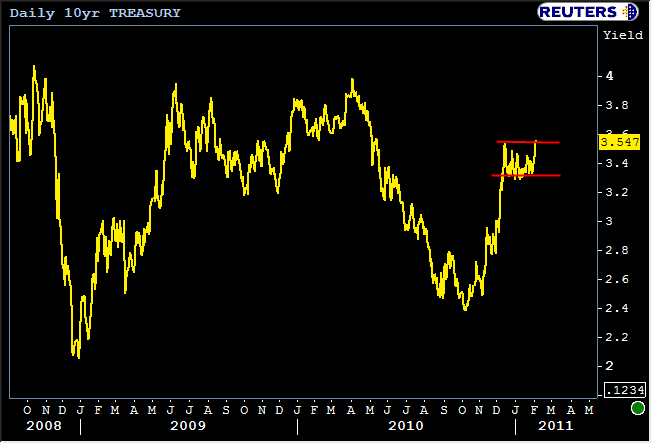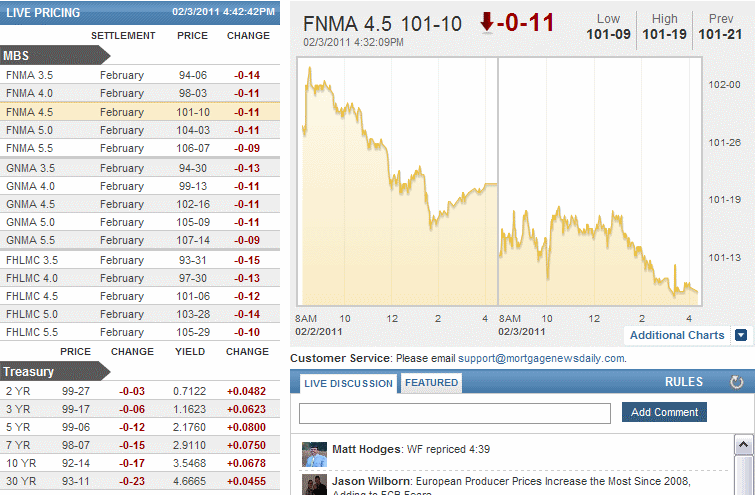The 4.875 sweet spot on C30 rate sheets didn't really changed much when benchmarks traded between 3.3 and 3.50. But outside those marks (3.56 is an outer limit), it's a different story.
The best execution 30 year fixed mortgage rate has moved up to 5.00%.
What we're looking at tomorrow is an "either/or" test for the bond market that could result in the duration shift we've been talking about so much recently. Unlike the previous NFP, this time around, we're testing to either stay inside the recent range or confirm a break out in the wrong direction.
If today's little foray over 3.5 is confirmed tomorrow, then the next technical target is around 3.70, and that could happen quickly. Historical examples where the sort of range-bind we've been in have acted as true "bear flags" almost always have that flag pattern as an isolated amount of time that stands out in the middle of a larger trend. That's scary stuff... But it has not yet been decided! It can't be truly decided until tomorrow.
Here's how the range looks in the grand scheme of things...

And a shot of the damage in MBS and beyond...

Here's the NFP Preview from Reuters:
U.S. hiring probably gathered steam in January, marking a fourth straight month of gains, but likely not enough to prevent the jobless rate from ticking up. Nonfarm payrolls are expected to have increased by 145,000 jobs, but severe snow storms that blanketed large parts of the country during the survey period could result in a much lower figure. The weather effect, however, might be minimized by the hiring of workers to clean up and repair damage. Following last February's blizzards, the Bureau of Labor Statistics said in order for severe weather conditions to reduce the estimate to payroll employment, employees have to be off work for an entire pay period and not paid for the time missed. Workers who received pay for any part of the reference pay period, even one hour, were counted in February's payroll employment figures.
Economists estimate the weather restrained payroll growth by some 15,000 to 70,000 in January. The report on Friday will nevertheless likely confirm a gradual labor market recovery and support the Federal Reserve's intention to complete its $600 billion government bond buying program to support the economy.
The labor market has lagged the broader economy, which grew at a 3.2 percent annual rate in the fourth quarter. The unemployment rate is expected to have edged up to 9.5 percent last month from 9.4 percent in November. The jobless rate will be one factor that could determine whether President Barack Obama gets a second term in office.
The private sector is again projected to generate all the jobs in January with an expected gain of 155,000, likely driven by the services sector. Payroll increases in goods-producing were likely limited by the severe weather, whose impact was probably felt the most in construction.
Manufacturing employment probably grew for a second straight month. The Institute for Supply Management's measure of manufacturing employment jumped in January to its highest since April 1973.
Government payrolls are expected to have dropped by about 10,000 in January, marking a third straight month of declines.
The Labor Department will also finalize its annual benchmark revisions to its payroll series, and it is expected to confirm that job losses in the 12 months to March 2010 were deeper than previously reported. The government's preliminary estimate released in October suggested the level of payrolls during the period could be revised down by 366,000.
The payrolls data will also reflect a revision to the model the government uses to estimate business births and deaths. Starting with the January report, the department will begin revising this birth/death model quarterly instead of annually.
Changes will also be implemented to the separate household survey from which the jobless rate is derived to show unemployment duration of up to five years from two currently.
In addition, the January household data will incorporate a new adjustment for the size of population. This would make the month's labor force, employment and unemployment levels not directly comparable to December's figures, and could complicate efforts to determine exactly why the unemployment rate moved.
MARKET IMPACT
There's little space for an upside surprise that could boost stocks, specially with the market near 2-1/2-year highs.
If there's a sharp increase in the unemployment rate, investors will probably want to take some profits ahead of the weekend, specially if the unrest in parts of the Middle East and North Africa remains unresolved.
The S&P 500 faces strong resistance near 1,313, a high hit in August 2008 and one of the few technical hurdles before 1,400. On the downside, short-term support levels are seen near 1,290, the 14-day moving average, and then in the 1,270 area.
The bond market is vulnerable to a sharp sell-off if hirings accelerate more than expected as this would support the notion that the economic recovery is gaining momentum. That would allow the Fed to consider reducing monetary stimulus as faster growth is often accompanied by higher inflation.
On the other hand, a disappointing jobs report should stoke bids for bonds on renewed worries over the strength of the economy and calm recent chatter that inflation is picking up. (Polling by Bangalore unit; Reporting by Lucia Mutikani in Washington and Rodrigo Campos and Richard Leong in New York; Editing by James Dalgleish)





